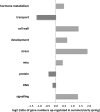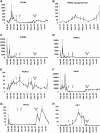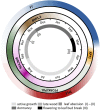Poplar wood rays are involved in seasonal remodeling of tree physiology
- PMID: 22992511
- PMCID: PMC3490584
- DOI: 10.1104/pp.112.202291
Poplar wood rays are involved in seasonal remodeling of tree physiology
Abstract
Understanding seasonality and longevity is a major challenge in tree biology. In woody species, growth phases and dormancy follow one another consecutively. In the oldest living individuals, the annual cycle may run for more than 1,000 years. So far, however, not much is known about the processes triggering reactivation from dormancy. In this study, we focused on wood rays, which are known to play an important role in tree development. The transition phase from dormancy to flowering in early spring was compared with the phase of active growth in summer. Rays from wood samples of poplar (Populus × canescens) were enriched by laser microdissection, and transcripts were monitored by poplar whole-genome microarrays. The resulting seasonally varying complex expression and metabolite patterns were subjected to pathway analyses. In February, the metabolic pathways related to flower induction were high, indicating that reactivation from dormancy was already taking place at this time of the year. In July, the pathways related to active growth, like lignin biosynthesis, nitrogen assimilation, and defense, were enriched. Based on "marker" genes identified in our pathway analyses, we were able to validate periodical changes in wood samples by quantitative polymerase chain reaction. These studies, and the resulting ray database, provide new insights into the steps underlying the seasonality of poplar trees.
Figures






References
-
- Ache P, Fromm J, Hedrich R. (2010) Potassium-dependent wood formation in poplar: seasonal aspects and environmental limitations. Plant Biol (Stuttg) 12: 259–267 - PubMed
-
- Arend M, Fromm J. (2003) Ultrastructural changes in cambial cell derivatives during xylem differentiation in poplar. Plant Biol 5: 255–264
-
- Arend M, Fromm J. (2007) Seasonal change in the drought response of wood cell development in poplar. Tree Physiol 27: 985–992 - PubMed
-
- Arend M, Stinzing A, Wind C, Langer K, Latz A, Ache P, Fromm J, Hedrich R. (2005) Polar-localised poplar K+ channel capable of controlling electrical properties of wood-forming cells. Planta 223: 140–148 - PubMed
Publication types
MeSH terms
Substances
LinkOut - more resources
Full Text Sources
Other Literature Sources
Molecular Biology Databases

